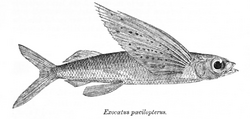| Cypselurus | |
|---|---|
 | |
| Yellow-wing Flying Fish ( C. poecilopterus ) | |
| Scientific classification | |
| Kingdom: | Animalia |
| Phylum: | Chordata |
| Class: | Actinopterygii |
| Order: | Beloniformes |
| Family: | Exocoetidae |
| Subfamily: | Cypsellurinae |
| Genus: | Cypselurus Swainson, 1838 |
| Type species | |
| Exocoetus appendiculatus, a synonym of Cypselurus comatus | |
| Species | |
Twelve recognized - see text. | |
Cypselurus is a genus of flying fish in the family Exocoetidae. They are found across Indo-Pacific to western Atlantic ocean.